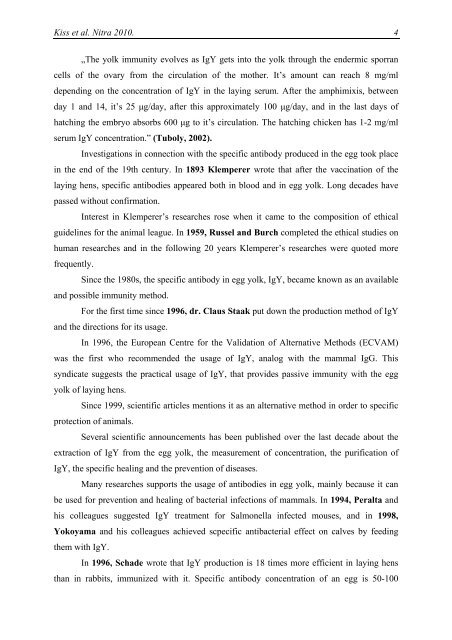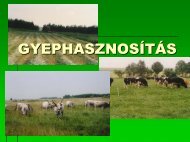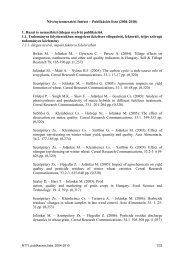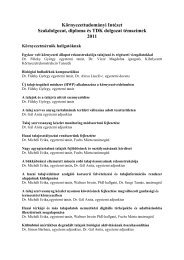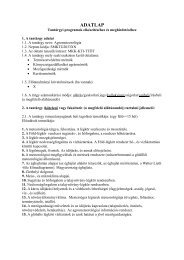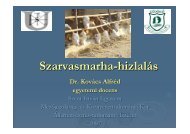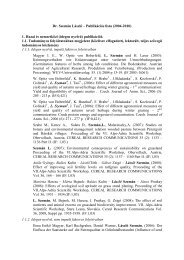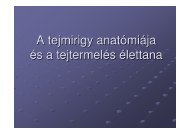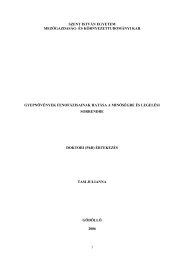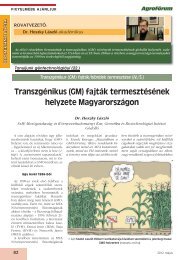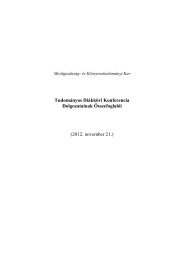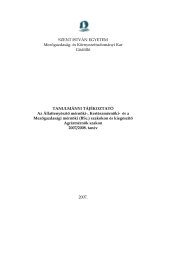Seasonal variations of yolk colour and IgY concentration in natural ...
Seasonal variations of yolk colour and IgY concentration in natural ...
Seasonal variations of yolk colour and IgY concentration in natural ...
- No tags were found...
Create successful ePaper yourself
Turn your PDF publications into a flip-book with our unique Google optimized e-Paper software.
Kiss et al. Nitra 2010. 4„The <strong>yolk</strong> immunity evolves as <strong>IgY</strong> gets <strong>in</strong>to the <strong>yolk</strong> through the endermic sporrancells <strong>of</strong> the ovary from the circulation <strong>of</strong> the mother. It’s amount can reach 8 mg/mldepend<strong>in</strong>g on the <strong>concentration</strong> <strong>of</strong> <strong>IgY</strong> <strong>in</strong> the lay<strong>in</strong>g serum. After the amphimixis, betweenday 1 <strong>and</strong> 14, it’s 25 μg/day, after this approximately 100 μg/day, <strong>and</strong> <strong>in</strong> the last days <strong>of</strong>hatch<strong>in</strong>g the embryo absorbs 600 μg to it’s circulation. The hatch<strong>in</strong>g chicken has 1-2 mg/mlserum <strong>IgY</strong> <strong>concentration</strong>.” (Tuboly, 2002).Investigations <strong>in</strong> connection with the specific antibody produced <strong>in</strong> the egg took place<strong>in</strong> the end <strong>of</strong> the 19th century. In 1893 Klemperer wrote that after the vacc<strong>in</strong>ation <strong>of</strong> thelay<strong>in</strong>g hens, specific antibodies appeared both <strong>in</strong> blood <strong>and</strong> <strong>in</strong> egg <strong>yolk</strong>. Long decades havepassed without confirmation.Interest <strong>in</strong> Klemperer’s researches rose when it came to the composition <strong>of</strong> ethicalguidel<strong>in</strong>es for the animal league. In 1959, Russel <strong>and</strong> Burch completed the ethical studies onhuman researches <strong>and</strong> <strong>in</strong> the follow<strong>in</strong>g 20 years Klemperer’s researches were quoted morefrequently.S<strong>in</strong>ce the 1980s, the specific antibody <strong>in</strong> egg <strong>yolk</strong>, <strong>IgY</strong>, became known as an available<strong>and</strong> possible immunity method.For the first time s<strong>in</strong>ce 1996, dr. Claus Staak put down the production method <strong>of</strong> <strong>IgY</strong><strong>and</strong> the directions for its usage.In 1996, the European Centre for the Validation <strong>of</strong> Alternative Methods (ECVAM)was the first who recommended the usage <strong>of</strong> <strong>IgY</strong>, analog with the mammal IgG. Thissyndicate suggests the practical usage <strong>of</strong> <strong>IgY</strong>, that provides passive immunity with the egg<strong>yolk</strong> <strong>of</strong> lay<strong>in</strong>g hens.S<strong>in</strong>ce 1999, scientific articles mentions it as an alternative method <strong>in</strong> order to specificprotection <strong>of</strong> animals.Several scientific announcements has been published over the last decade about theextraction <strong>of</strong> <strong>IgY</strong> from the egg <strong>yolk</strong>, the measurement <strong>of</strong> <strong>concentration</strong>, the purification <strong>of</strong><strong>IgY</strong>, the specific heal<strong>in</strong>g <strong>and</strong> the prevention <strong>of</strong> diseases.Many researches supports the usage <strong>of</strong> antibodies <strong>in</strong> egg <strong>yolk</strong>, ma<strong>in</strong>ly because it canbe used for prevention <strong>and</strong> heal<strong>in</strong>g <strong>of</strong> bacterial <strong>in</strong>fections <strong>of</strong> mammals. In 1994, Peralta <strong>and</strong>his colleagues suggested <strong>IgY</strong> treatment for Salmonella <strong>in</strong>fected mouses, <strong>and</strong> <strong>in</strong> 1998,Yokoyama <strong>and</strong> his colleagues achieved scpecific antibacterial effect on calves by feed<strong>in</strong>gthem with <strong>IgY</strong>.In 1996, Schade wrote that <strong>IgY</strong> production is 18 times more efficient <strong>in</strong> lay<strong>in</strong>g hensthan <strong>in</strong> rabbits, immunized with it. Specific antibody <strong>concentration</strong> <strong>of</strong> an egg is 50-100


